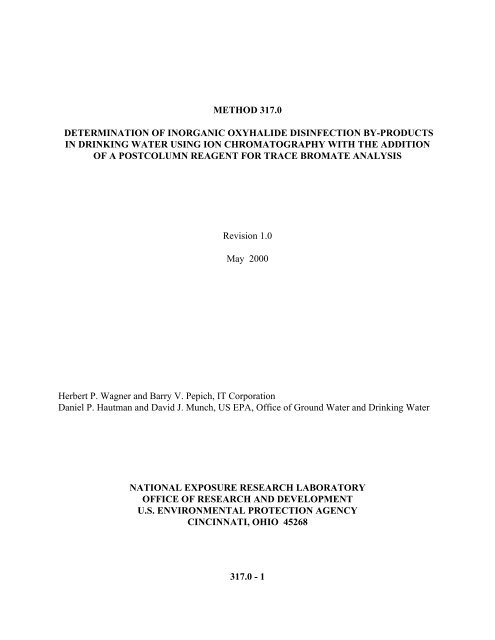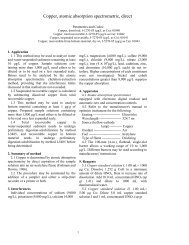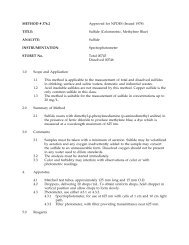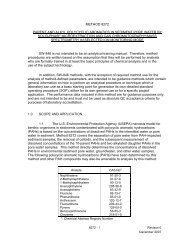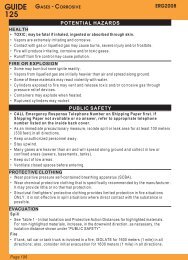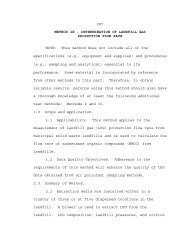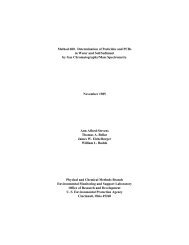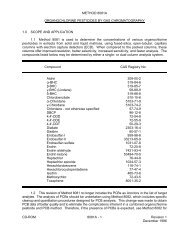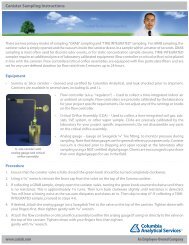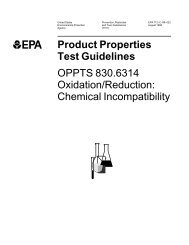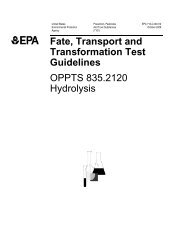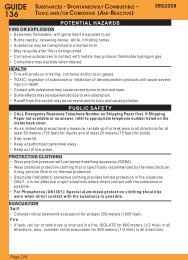EPA Method 317 - Columbia Analytical Services
EPA Method 317 - Columbia Analytical Services
EPA Method 317 - Columbia Analytical Services
- No tags were found...
Create successful ePaper yourself
Turn your PDF publications into a flip-book with our unique Google optimized e-Paper software.
METHOD <strong>317</strong>.0DETERMINATION OF INORGANIC OXYHALIDE DISINFECTION BY-PRODUCTSIN DRINKING WATER USING ION CHROMATOGRAPHY WITH THE ADDITIONOF A POSTCOLUMN REAGENT FOR TRACE BROMATE ANALYSIS1. SCOPE AND APPLICATION1.1 This method covers the determination of inorganic oxyhalide disinfection by-productanions in reagent water, surface water, ground water, and finished drinking water. Inaddition, bromide can be accurately determined in source or raw water and it has beenincluded due to its critical role as a disinfection by-product precursor. Bromideconcentration in finished water can differ significantly between preserved andunpreserved samples and should not be attempted due to numerous variables which caninfluence the concentration. Since this method, prior to the addition of the postcolumnreagent (PCR), employs the same hardware as <strong>EPA</strong> <strong>Method</strong> 300.1 1 , the analysis of thecommon anions (using <strong>EPA</strong> <strong>Method</strong> 300.1, Part A 1 ) can be performed using thisinstrument setup with the postcolumn hardware attached but “off-line” and with theappropriate smaller sample loop.Inorganic Disinfection By-products by Conductivity DetectionBromate (report values > 15.0 ug/L)ChloriteBromide (source or raw water only)ChlorateInorganic Disinfection By-product by Postcolumn UV/VIS Absorbance DetectionBromate (report values > Minimum Reporting Limit (MRL) to 15.0 ug/L)1.2 The single laboratory reagent water <strong>Method</strong> Detection Limits (MDL, defined in Section3.14) for the above analytes are listed in Table 1. The MDL for a specific matrix maydiffer from those listed, depending upon the nature of the sample and the specificinstrumentation employed.1.2.1 In order to achieve comparable detection limits on the conductivity detector, anion chromatographic system must utilize suppressed conductivity detection, beproperly maintained and must be capable of yielding a baseline with no morethan 5 nanosiemen (nS) noise/drift per minute of monitored response over thebackground conductivity.1.2.2 In order to achieve acceptable detection limits on the postcolumn absorbancedetector, the postcolumn reagent must be delivered pneumatically and someform of software signal filtering or smoothing of the absorbance signal from theabsorbance detector must be incorporated. 2<strong>317</strong>.0 - 2
1.3 This method is recommended for use only by or under the supervision of analystsexperienced in the use of ion chromatography and in the interpretation of the resultingion chromatograms.1.4 When this method is used to analyze unfamiliar samples for any of the above anions,anion identification should be supported by the use of a fortified sample matrixcovering the anions of interest. The fortification procedure is described in Section9.4.1.1.5 Users of the method data should state the data quality objectives prior to analysis.Users of the method must demonstrate the ability to generate acceptable results withthis method, using the procedures described in Section 9.0.2. SUMMARY OF METHOD2.1 A volume of sample, approximately 225 uL (see Note), is introduced into an ionchromatograph (IC). The anions of interest are separated and measured, using a systemcomprised of a guard column, analytical column, suppressor device, conductivitydetector, a postcolumn reagent delivery system (pneumatically controlled), a heatedpostcolumn reaction coil, and a ultraviolet/visible (UV/VIS) absorbance detector. 2,3NOTE: A 225 uL sample loop can be made using approximately 111 cm (44 inches)of 0.02 inch i.d. PEEK tubing. Larger injection loops may be employed. 4The volume should be verified to be within 5% by weighing the sample loopempty, filling the loop with deionized water and re-weighing the loopassuming the density of water is 1 mg/uL.3. DEFINITIONS3.1 ANALYSIS BATCH – A sequence of samples, which are analyzed within a 30 hourperiod and include no more than 20 field samples. An analysis batch must also includeall required QC samples, which do not contribute to the maximum field sample total of20. The required QC samples include:• Laboratory Reagent Blank (LRB)• Initial Calibration Check Standard (ICCS)• Laboratory Fortified Blank (LFB)• Continuing Calibration Check Standard (CCCS), when the batch contains more than10 field samples• End Calibration Check Standard (ECCS)• Laboratory Fortified Matrix (LFM)• Either a Field Duplicate (FD), a Laboratory Duplicate (LD) or a duplicate of the LFM3.2 CALIBRATION STANDARD (CAL) – A solution prepared from the primary dilutionstandard solution(s) or stock standard solutions and the surrogate analyte. The CAL<strong>317</strong>.0 - 3
solutions are used to calibrate the instrument response with respect to analyteconcentration.3.3 INITIAL CALIBRATION STANDARDS – A series of CAL solutions (eitherindividual or combined target analytes) used to initially establish instrument calibrationand develop calibration curves for individual target anions (Section 10.2).3.4 INITIAL CALIBRATION CHECK STANDARD (ICCS) – A CAL solution, (eitherindividual or combined target analytes) which is analyzed initially, prior to any fieldsample analyses, which verifies previously established calibration curves. Theconcentration for the initial calibration check standard MUST be at or below the MRL(Section 3.15) level which is also the level of the lowest calibration standard (Section10.3.1).3.5 CONTINUING CALIBRATION CHECK STANDARDS (CCCS) – A CAL solution(either individual or combined target analytes) which is analyzed after every tenth fieldsample analyses which verifies the previously established calibration curves andconfirms accurate analyte quantitation for the previous ten field samples analyzed. Theconcentration for the continuing calibration check standards should be either at amiddle calibration level or at the highest calibration level (Section 10.3.2).3.6 END CALIBRATION CHECK STANDARD (ECCS) – A CAL solution (eitherindividual or combined target analytes) which is analyzed after the last field sampleanalysis which verifies the previously established calibration curves and confirmsaccurate analyte quantitation for all field samples analyzed since the last continuingcalibration check. The end calibration check standard should be either the middle orhigh level continuing calibration check standard (Section 10.3.2).3.7 FIELD DUPLICATES (FD) – Two separate field samples collected at the same timeand place under identical circumstances and handled exactly the same throughout fieldand laboratory procedures. Analyses of field duplicates indicate the precisionassociated with sample collection, preservation and storage, as well as with laboratoryprocedures.3.8 INSTRUMENT PERFORMANCE CHECK SOLUTION (IPC) – A solution of one ormore method analytes, surrogates, or other test substances used to evaluate theperformance of the instrument system with respect to a defined set of criteria.3.9 LABORATORY DUPLICATE (LD) – Two sample aliquots, taken in the laboratoryfrom a single field sample bottle, and analyzed separately with identical procedures.Analysis of the initial sample (I C ) and the duplicate sample [(D C ) Section 9.4.3.1]indicate precision associated specifically with the laboratory procedures by removingvariation contributed from sample collection, preservation and storage procedures.<strong>317</strong>.0 - 4
3.10 LABORATORY FORTIFIED BLANK (LFB) – An aliquot of reagent water or otherblank matrix to which known quantities of the method analytes are added in thelaboratory. The LFB is analyzed exactly like a sample, and its purpose is to determinewhether the methodology is in control, and whether the laboratory is capable of makingaccurate and precise measurements.3.11 LABORATORY FORTIFIED SAMPLE MATRIX (LFM) – An aliquot of anenvironmental field sample to which known quantities of the method analytes are addedin the laboratory. The LFM is analyzed exactly like a sample, and its purpose is todetermine whether the field sample matrix contributes bias to the analytical result. Thebackground concentrations of the analytes in the field sample matrix must bedetermined in a separate, unfortified aliquot and the measured values in the LFMcorrected for background concentrations.3.12 LABORATORY REAGENT BLANK (LRB) – An aliquot of reagent water or otherblank matrix that is handled exactly as a sample including exposure to all glassware,equipment, solvents, reagents, and surrogates that are used with other samples. TheLRB is used to determine if method analytes or other interferences are present in thelaboratory environment, the reagents, or the apparatus.3.13 MATERIAL SAFETY DATA SHEET (MSDS) – Written information provided byvendors concerning a chemical's toxicity, health hazards, physical properties, fire, andreactivity data including storage, spill, and handling precautions.3.14 METHOD DETECTION LIMIT (MDL) – The minimum concentration of an analytethat can be identified, measured and reported with 99% confidence that the analyteconcentration is greater than zero. 53.15 MINIMUM REPORTING LEVEL (MRL) – The minimum concentration that can bereported as a quantitated value for a target analyte in a sample following analysis. Thisdefined concentration can be no lower than the concentration of the lowest calibrationstandard and can only be used if acceptable quality control criteria for the ICCS are met.3.16 PROFICIENCY TESTING (PT) or PERFORMANCE EVALUATION (PE) SAMPLE– A certified solution of method analytes whose concentration is unknown to theanalyst. Frequently, an aliquot of this solution is added to a known volume of reagentwater and analyzed with procedures used for samples. Often, results of these analysesare used as part of a laboratory certification program to objectively determine thecapabilities of a laboratory to achieve high quality results.3.17 QUALITY CONTROL SAMPLE (QCS) – A solution of method analytes of knownconcentrations that is obtained from a source external to the laboratory and differentfrom the source of calibration standards. It is used to check laboratory performancewith externally prepared test materials.<strong>317</strong>.0 - 5
3.18 SURROGATE ANALYTE – An analyte added to all samples, standards, blanks, etc.,which is unlikely to be found at a significant concentration, and which is added directlyin a known amount before any sample processing procedures are conducted (except inthe procedure for the removal of chlorite as described is Section 11.1.4). It is measuredwith the same procedures used to measure other sample components. The purpose ofthe surrogate analyte is to monitor method performance with each sample.3.19 STOCK STANDARD SOLUTION (SSS) – A concentrated solution containing one ormore method analytes prepared in the laboratory using assayed reference materials orpurchased from a reputable commercial source.4. INTERFERENCES4.1 Interferences can be divided into three different categories: direct chromatographiccoelution, where an analyte response is observed at very nearly the same retention timeas the target anion; concentration dependant coelution, which is observed when theresponse of higher than typical concentrations of the neighboring peak overlap into theretention window of the target anion; and, ionic character displacement, where retentiontimes may significantly shift due to the influence of high ionic strength matrices (highmineral content or hardness) overloading the exchange sites on the column andsignificantly shortening target analyte's retention times.4.1.1 A direct chromatographic coelution may be solved by changing columns, eluentstrength, modifying the eluent with organic solvents (if compatible with ICcolumns), changing the detection systems, or selective removal of theinterference with pretreatment. Sample dilution will have little to no effect.The analyst must verify that these changes do not induce any negative affects onmethod performance by repeating and passing all the QC criteria as described inSection 9.4.1.2 Sample dilution may resolve some of the difficulties if the interference is theresult of either concentration dependant coelution or ionic characterdisplacement, but it must be clarified that sample dilution will alter yourMinimum Reporting Limit (MRL) by a proportion equivalent to that of thedilution. Therefore, careful consideration of project objectives should be givenprior to performing such a dilution. An alternative to sample dilution, may bedilution of the eluent as outlined in Section 11.2.6.4.1.3 Pretreatment cartridges can be effective as a means to eliminate certain matrixinterferences. With any proposed pretreatment, the analyst must verify thattarget analyte(s) are not affected by monitoring recovery after pretreatment.With advances in analytical separator column technology which employ higher<strong>317</strong>.0 - 6
capacity anion exchange resins, the need for these cartridges has been greatly reduced.4.2 <strong>Method</strong> interferences may be caused by contaminants in the reagent water, reagents,glassware, and other sample processing apparatus that lead to discrete artifacts orelevated baselines in an ion chromatogram. These interferences can lead to falsepositive results for target analytes as well as reduced detection limits as a consequenceof elevated baseline noise.4.3 Samples that contain particles larger than 0.45 microns and reagent solutions thatcontain particles larger than 0.20 microns require filtration to prevent damage toinstrument columns and flow systems.4.4 Close attention should be given to the potential for carry over peaks from one analysiswhich will effect the proper detection of analytes of interest in a second or subsequentanalysis. Normally, in this analysis, the elution of sulfate (retention time of 17.5 min.)indicates the end of a chromatographic run, but, in the ozonated and chlorine dioxidematrices, which were included as part of the single operator accuracy and bias study, asmall response (200 nS baseline rise) was observed for a very late eluting unknownpeak following the response for sulfate. Consequently, a run time of 25 minutes isrecommended to allow for the proper elution of any potentially interferant late peaks. Itis the responsibility of the user to confirm that no late eluting peaks have carried overinto a subsequent analysis thereby compromising the integrity of the analytical results.4.5 Any residual chlorine dioxide present in the sample will result in the formation ofadditional chlorite prior to analysis. If residual chlorine dioxide is suspected in thesample, the sample must be purged with an inert gas (helium, argon or nitrogen) forapproximately five minutes. This sparging must be conducted prior to ethylenediaminepreservation and at the time of sample collection.4.6 The presence of chlorite can interfere with the quantitation of low concentrations ofbromate on the postcolumn UV/VIS absorbance detector. In order to accuratelyquantify bromate concentrations in the range 0.5 - 15.0 ug/L in this postcolumn system,the excess chlorite must be removed prior to analysis as outlined in Section 11.1.4.5. SAFETY5.1 The toxicity or carcinogenicity of each reagent used in this method have not been fullyestablished although the postcolumn reagent o-dianisidine, is listed as a potentialhuman carcinogen. Each chemical should be regarded as a potential health hazard andexposure should be as low as reasonably achievable. Cautions are included for knownextremely hazardous materials or procedures.5.2 Each laboratory is responsible for maintaining a current awareness file of OccupationalSafety and Health Administration (OSHA) regulations regarding the safe handling of<strong>317</strong>.0 - 7
the chemicals specified in this method. A reference file of Material Safety Data Sheets(MSDS) should be made available to all personnel involved in the chemical analysis.The preparation of a formal safety plan is also advisable. Additional references onlaboratory safety are available. 6-95.3 The following chemicals have the potential to be highly toxic or hazardous, consultMSDS.5.3.1 Sulfuric acid – used to prepared a 25 mN sulfuric acid regenerant solution forchemical suppression using a Dionex Anion Micro Membrane Suppressor(AMMS) and for pretreatment for chlorite removal (Section 11.1.4)5.3.2 Nitric acid – used to prepare the postcolumn reagent.5.3.3 o-dianisidine [3, 3'- dimethoxybenzidine dihydrochloride (ODA)] – used as thepostcolumn reagent.6. EQUIPMENT AND SUPPLIES6.1 Ion chromatograph – <strong>Analytical</strong> system complete with ion chromatographic pump andall required accessories including syringes, analytical columns, compressed gasses,suppressor, conductivity detector, mixing “tee”, postcolumn reagent delivery system,reaction coil, reaction coil heater, UV/VIS absorbance detector (Figure 1) and a PCbased data acquisition and control system.NOTE: Because of its acidic nature and high salt content, the PCR MUST be flushedfrom the reaction coil upon completion of the final analysis and preventedfrom draining through the reaction coil by gravity once the system is shutdown. This can be accomplished either manually or by incorporating acolumn switching valve in combination with a flush and close method in theschedule.6.1.1 Anion guard column – Dionex AG9-HC 4 mm (P/N 51791), or equivalent.This column functions as a protector of the separator column. If omitted fromthe system the retention times will be shorter.6.1.2 Anion separator column – Dionex AS9-HC column, 4 mm (P/N 51786), orequivalent (see Note). The AS9-HC, 4 mm column using the conditions outlinedin Table 1 produced the separations shown in Figures 2 and 3.NOTE: The use of 2 mm columns is not recommended. A 50 uL sample loopwould be required with the 2 mm columns. This reduced injectionvolume would decrease the “on-column” bromate and negatively affectPCR reactivity and the subsequent absorbance response. As well, the<strong>317</strong>.0 - 8
2 mm columns require a flow rate approximately 4 times less than the4 mm columns. At the lower flow rates, band broading may becomean issue and it would be difficult, if not impossible, to accuratelymaintain the appropriate reduced flow rate for the PCR.6.1.3 Anion suppressor device – The data presented in this method were generatedusing a Dionex Anion Self Regenerating Suppressor (4 mm ASRS, P/N 46081).An equivalent suppressor device may be utilized provided comparableconductivity detection limits are achieved and adequate baseline stability isattained as measured by a combined baseline drift/noise of no more than 5 nSper minute over the background conductivity. The suppressor must be able towithstand approximately 80 - 120 psi back pressure which results fromconnecting the postcolumn hardware to the eluent out side of the suppressor.6.1.3.1 The ASRS was set to perform electrolytic suppression at a currentsetting of 100 mA using the external water mode. Insufficient baselinestability was observed on the conductivity detector using the ASRS inrecycle mode.6.1.3.2 This method was developed as a multiple component procedureemploying both suppressed conductivity and postcolumn UV/VISabsorbance detectors in series. If a laboratory is exclusively interestedin monitoring trace bromate using the PCR and the UV/VISabsorbance detector, the suppressor may not be required. Theperformance data presented within this method for the PCR andUV/VIS absorbance detector, is based upon a suppressed mobile phasesystem. A laboratory must generate comparable data as a result of acomplete IDC (Section 9.2) in order to demonstrate comparability of anon suppressed system.6.1.4 Detector – Conductivity cell (Dionex CD20, or equivalent) capable of providingdata as required in Section 9.2.6.1.5 Detector – Absorbance detector (Dionex AD20 or equivalent with 10 mm cellpathlength, equipped with a tungsten source bulb, or equivalent and capable ofmeasuring absorbance at 450 nm) capable of providing data as required inSection 9.2.6.1.6 Postcolumn reagent delivery system (Dionex PC-10, or equivalent),pneumatically delivers the postcolumn reagent to mixing tee. The pressuresettings will need to be established on an individual basis for each specificinstrument configuration and at a level which yields the prescribed PCR flowrates.<strong>317</strong>.0 - 9
6.1.7 Reaction Coil, 500 uL internal volume, knitted, potted or configured to fitsecurely in the postcolumn reaction coil heater. (Dionex P/N 39349, orequivalent).6.1.8 Postcolumn Reaction Coil Heater, capable of maintaining 60°C. (Dionex PCH-2, or equivalent).6.2 Data System – The Dionex Peaknet Data Chromatography Software was used togenerate all the data in the attached tables. Other computer based data systems mayachieve approximately the same MDLs but the user must demonstrate this by theprocedure outlined in Section 9.2.6.3 <strong>Analytical</strong> balance – Used to accurately weigh target analyte salts for stock standardpreparation (±0.1 mg sensitivity).6.4 Top loading balance – Used to accurately weigh reagents to prepare eluents (±10 mgsensitivity).6.5 Weigh boats – Plastic, disposable - for weighing eluent reagents.6.6 Syringes – Plastic, disposable, 10 mL - used during sample preparation.6.7 Pipets – Pasteur, plastic or glass, disposable, graduated, 5 mL and 10 mL.6.8 Bottles – High density polyethylene (HDPE), opaque or glass, amber, 30 mL, 125 mL,250 mL, used for sample collection and storage of calibration solutions. Opaque oramber bottles are required due to the photoreactivity of the chlorite anion.6.9 Micro beakers – Plastic, disposable - used during sample preparation.6.10 Particulate filters – Gelman ion chromatography Acrodisc 0.45 micron (PN 4485)syringe filters or equivalent. These cartridges are used to remove particulates and[Fe(OH) 3(s) ] which is formed during the oxidation-reduction reaction between Fe (II)and ClO 2 - .6.11 Hydrogen cartridges – Dionex OnGuard-H cartridges (PN 039596) or equivalent.These cartridges are conditioned according to the manufacturer’s directions and areused to protect the analytical column and the suppressor membrane by removing excessferrous iron [Fe (II)]. The ferrous iron is added to field samples to reduce chloritelevels prior to analysis of chlorine dioxide disinfected water samples.7. REAGENTS AND STANDARDS<strong>317</strong>.0 - 10
7.1 Reagent water – Distilled or deionized water 18 M S or better, free of the anions ofinterest. Water should contain particles no larger than 0.20 microns.7.2 Eluent solution – Sodium carbonate (CASRN 497-19-8) 9.0 mM. Dissolve 1.91 gsodium carbonate (Na 2 CO 3 ) in reagent water and dilute to 2 L.7.2.1 This eluent solution must be purged for 10 minutes with helium prior to use toremove dissolved gases which may form micro bubbles in the IC compromisingsystem performance and adversely effecting the integrity of the data.Alternatively, an in-line degas apparatus may be employed.7.3 Stock standard solutions, 1000 mg/L (1 mg/mL) – Stock standard solutions may bepurchased as certified solutions or prepared from ACS reagent grade, potassium orsodium salts as listed below, for most analytes. Chlorite requires careful considerationas outlined below in Section 7.3.4.1.7.3.1 Bromide (Br - ) 1000 mg/L – Dissolve 0.1288 g sodium bromide (NaBr, CASRN7647-15-6) in reagent water and dilute to 100 mL in a volumetric flask.7.3.2 Bromate (BrO 3 - ) 1000 mg/L – Dissolve 0.1180 g of sodium bromate (NaBrO 3 ,CASRN 7789-38-0) in reagent water and dilute to 100 mL in a volumetric flask.7.3.3 Chlorate (C1O 3 - ) 1000 mg/L – Dissolve 0.1275 g of sodium chlorate (NaC1O 3 ,CASRN 7775-09-9) in reagent water and dilute to 100 mL in a volumetric flask.7.3.4 Chlorite (C1O 2 - ) 1000 mg/L – If the amperometric titration of the technicalgrade sodium chlorite (NaC1O 2 ), specified in 7.3.4.1, had indicated the purity ofthe salt to be 80.0 % NaC1O 2 , the analyst would dissolve 0.1676 g of sodiumchlorite (NaC1O 2 , CASRN 7758-19-2) in reagent water and dilute to 100 mL ina volumetric flask.7.3.4.1 High purity sodium chlorite (NaClO 2) is not currently commerciallyavailable due to its potential explosive instability. Recrystallization ofthe technical grade (approx. 80%) can be performed but it is laborintensive and time consuming. The simplest approach is to determinethe exact purity of the NaClO 2 using the iodometric titrationprocedure. 10 Following titration, an individual component standard ofchlorite must be analyzed to determine if there is any significantcontamination (greater than 1% of the chlorite weight) from chlorate,bromate or bromide (as other method target anions) in the technicalgrade chlorite standard.<strong>317</strong>.0 - 11
NOTE: Stability of standards – Stock standards (Section 7.3) for most anions arestable for at least 6 months when refrigerated at
sell inferior grades of o-dianisidine dihydrochloride. ONLY the purified gradeof this reagent is acceptable. The purified ODA dihydrochloride salt is a white,fine crystalline powder.NOTE: All glassware used to prepare the postcolumn reagent must bethoroughly rinsed with reagent water prior to use. A champagne orlight amber coloration of the PCR reagent may be evident when freshlyprepared. Over several hours, this slight coloration will fade.Consequently, the PCR must be prepared in advance and allowed to situntil it is clear, for a minimum of 4 hours (preferably overnight) priorto use. Occasionally, no matter how well all the glassware used toprepare the postcolumn reagent is rinsed, a darkly colored solution(oxidized ODA) may result. These solutions MUST be discarded. Forthis reason, it is recommended that the PCR be made in a series of 500mL lots with dedicated glassware. The clear solution should befiltered using a 0.45 micron membrane to remove particulates beforeuse.7.7 Ferrous iron [1000 mg/L Fe (II)] solution – Dissolve 0.124 g ferrous sulfateheptahydrate (FeSO4.7H2O, Sigma, F-7002) in approximately 15 mL reagent watercontaining 6 uL concentrated nitric acid and dilute to 25 mL with reagent water in avolumetric flask (final pH -2). The Fe (II) solution must be prepared fresh every twodays.7.8 Sulfuric acid (0.5 N) – Dilute 1.4 mL of concentrated sulfuric acid (Fisher ScientificCertified ACS Plus, A 300-500) to 100 mL.8. SAMPLE COLLECTION, PRESERVATION AND STORAGE8.1 Samples should be collected in plastic or glass bottles. All bottles must be thoroughlycleaned and rinsed with reagent water. The volume collected should be sufficient toinsure a representative sample, allow for replicate analysis and laboratory fortifiedmatrix analysis, if required, and minimize waste disposal.8.2 Special sampling requirements and precautions for chlorite.8.2.1 Sample bottles used for chlorite analysis must be opaque or amber to protect thesample from light.8.2.2 When preparing the LFM, be aware that chlorite is an oxidant and may reactwith the natural organic matter in an untreated drinking water matrix as a resultof oxidative demand. If untreated water is collected for chlorite analysis, andsubsequently used for the LFM, EDA preservation will not control this demandand reduced chlorite recoveries may be observed.<strong>317</strong>.0 - 13
8.3 Sample preservation and holding times for the anions are as follows:Analyte Preservation Holding TimeBromate 50 mg/L EDA, refrigerate at
Laboratory Fortified Blank (LFB), Instrument Performance Check Standard (IPC),Continuing Calibration Check Standards (CCCS), Laboratory Fortified Sample Matrix(LFM) and either a Field, Laboratory or LFM duplicate sample analysis. This sectiondetails the specific requirements for each of these QC parameters for both theconductivity and absorbance detectors used in this application. Although this methodinvolves both conductivity and absorbance detection, the MDLs and MRLs may differbut the QC requirements and acceptance criteria are the same for both detectors. TheQC criteria discussed in the following sections are summarized in Section 17, Tables 4and 5. The laboratory is required to maintain performance records that define thequality of the data that are generated.9.2 INITIAL DEMONSTRATION OF CAPABILITY9.2.1 The Initial Demonstration of Capability (IDC) – This is used to characterizeinstrument and laboratory performance prior to performing analyses by thismethod. The QC requirements for the IDC discussed in the following sectionare summarized in Section 17, Table 4.9.2.2 Initial demonstration of low system background – Section 9.3.1.9.2.3 Initial Demonstration of Precision (IDP) – For the 4 conductivity detectoranalytes, prepare 7 replicate LFBs fortified at a recommended concentration of20 ug/L. For the absorbance detector, prepare 7 replicate LFBs fortified at arecommended concentration of 2.0 ug/L bromate. The percent relative standarddeviation (RSD) of the results must be less than 20%.9.2.4 Initial Demonstration of Accuracy (IDA) – Using the data generated for Section9.2.3, calculate the average recovery. The average recovery of the replicatevalues must be within ± 15% of the true value.9.2.5 Quality Control Sample (QCS) – After calibration curves have initially beenestablished or have been re-established, on a quarterly basis or as required tomeet data quality needs, verify both the calibration and acceptable instrumentperformance with the preparation and analyses of an external/second sourceQCS. If the determined concentrations are not within ± 20% of the statedvalues, performance of the method is unacceptable. The source of the problemmust be identified and corrected before proceeding with the IDC.9.2.6 <strong>Method</strong> Detection Limit (MDL) – MDLs must be established for all analytes,using reagent water (blank) fortified at a concentration of three to five times theestimated instrument detection limit. 4 To determine MDL values, take sevenreplicate aliquots of the fortified reagent water and process through the entireanalytical method. The replicates must be prepared and analyzed over threedays. Report the concentration values in the appropriate units. Calculate theMDL as follows:<strong>317</strong>.0 - 15
MDL = (t) x (S)where,t = student's t value for a 99% confidence level and a standarddeviation estimate with n-1 degrees of freedom[t = 3.14 for seven replicates], andS = standard deviation of the replicate analyses.9.2.6.1 MDLs should be periodically verified, but MUST be initiallydetermined when a new operator begins work or whenever there is asignificant change in the background, or instrument response.NOTE: Do not subtract blank values when performing MDL calculations.9.2.7 Minimum Reporting Level (MRL) – The MRL is the threshold concentration ofan analyte that a laboratory can expect to accurately quantitate in an unknownsample. The MRL should be established at an analyte concentration eithergreater than three times the MDL or at a concentration which would yield aresponse greater than a signal to noise ratio of five. Setting the MRL too lowmay cause repeated QC failure upon analysis of the ICCS. Although the lowestcalibration standard may be below the MRL, the MRL must never beestablished at a concentration lower than the lowest calibration standard.9.3 ASSESSING LABORATORY PERFORMANCE9.3.1 Laboratory Reagent Blank (LRB) – The laboratory must analyze at least oneLRB with each analysis batch (Section 3.1). Data produced are used to assesscontamination from the laboratory environment. Values that exceed ½ the MRLindicate a laboratory or reagent contamination is present. If a method analyte isobserved in the LRB it must not exceed ½ the MRL. Analytes that exceed thislevel will invalidate the analysis batch for that method analyte in allcorresponding field samples.9.3.1.1 EDA must be added to the LRB at 50 mg/L. By including EDA in theLRB, any bias as a consequence of the EDA which may be observed inthe field samples, particularly in terms of background contamination,will be identified.9.3.1.2 When the PCR method is used for low level bromate analysis onsamples from public water systems (PWSs) which employ chlorinedioxide disinfection, the matrix must be pretreated to remove thepotentially interferant chlorite anion (Section 11.1.4). When thesetypes of pretreated samples, or any type of pretreatment is applied tofield samples included as part of an analysis batch, a second LRB must<strong>317</strong>.0 - 16
e prepared, pretreated and analyzed to confirm no background effectsof the pretreatment are present. If the analysis batch contains onlypretreated samples, then only a pretreated LRB is required.9.3.2 Laboratory Fortified Blank (LFB) – Prepare a secondary dilution stock using thesame stock solutions used to prepare the calibration standards and the LFMfortification solution. Since calibration solutions are prepared in large volumesand can be used over an extended period of time, the integrity of theconcentration of the solution used to fortify the LFM is checked by analyzingthe LFB. The recovery of all analytes must fall in the acceptable recovery range,as indicated below, prior to analyzing samples. If the LRB recovery for ananalysis batch does not meet these recovery criteria the data are consideredinvalid, and the source of the problem must be identified and resolved beforecontinuing with analyses.LFB Fortified Concentration range LFB Percent Recovery LimitsMRL to 5 x MRL 75 - 125 %5 x MRL to highest calibration level 85 - 115 %9.3.2.1 EDA must be added to the LFB at 50 mg/L. The addition of EDA toall reagent water prepared calibration and quality control samples isrequired not as a preservative but rather as a means to normalize anybias attributed by the presence of EDA in the field samples.9.3.3 Instrument Performance Check (IPC) – The Initial Calibration Check Standard(ICCS) is to be evaluated as the IPC solution in order to confirm properinstrument performance. As specified in Section 10.3.1, this must be done usingthe lowest calibration standard or the standard level established as the MRL.This analysis confirms the MRL and demonstrates proper chromatographicperformance at the beginning of each analysis batch. Chromatographicperformance is judged by calculating the Peak Gaussian Factor (PGF), which isa means to measure peak symmetry and monitoring retention time drift in thesurrogate peak over time. If these criteria are not met, corrective action must beperformed prior to analyzing additional samples. Major maintenance likereplacing columns require rerunning the IDC (Section 9.2).9.3.3.1 Critically evaluate the surrogate peak in the initial calibration checkstandard, and calculate the PGF as follows:1.83 x W(½)PGF = -----------------------W ( 1 / 10 )where,W(½) is the peak width at half height, andW ( 1 / 10 ) is the peak width at tenth height.<strong>317</strong>.0 - 17
NOTE: Values for W(½) and W ( 1 / 10 ) can be attained through mostdata acquisition software.9.3.3.2 Small variations in retention time can be anticipated when a newsolution of eluent is prepared but if sudden shifts of more than 5% areobserved in the surrogate retention time, some type of instrumentproblem is present. Potential problems include improperly preparedeluent, erroneous method parameters programmed such as flow rate orsome other system problem. The chromatographic profile (elutionorder) of the target anions following an ion chromatographic analysisshould closely replicate the profile displayed in the test chromatogramthat was shipped when the column was purchased. As a column ages, itis normal to see a gradual shift and shortening of retention times, but ifafter several years of use, extensive use over less than a year, or usewith harsh samples, this retention time has noticeably shifted to anyless than 80% of the original recorded value, the column requirescleaning or replacement; especially if resolution problems arebeginning to become common between previously resolved peaks. Alaboratory should retain a historic record of retention times for thesurrogate and all the target anions to provide evidence of an analyticalcolumns vitality.9.3.3.3 If a laboratory chooses to monitor exclusively for trace bromate usingPCR and the UV/VIS absorbance detector, and no other analytes arebeing monitored on the conductivity detector, the surrogate may beomitted from the procedure. In this case, no measurement of PGF isrequired. However, the laboratory must carefully monitor the bromateretention time in the ICCS as an alternate to the surrogate retentiontime and, in the same manner, adhere to those specifications set forthin Section 9.3.3.2. During the course of the analysis, bromate retentiontimes in the CCCS and ECCS must also be closely monitored to becertain they adhere to the QC requirements set forth in Section10.3.2.2.9.4 ASSESSING ANALYTE RECOVERY AND DATA QUALITY9.4.1 Laboratory Fortified Sample Matrix (LFM) – The laboratory must add a knownamount of each target analyte to a minimum of 5% of the collected field samplesor at least one with every analysis batch, whichever is greater. Additional LFMrequirements, as described in Section 9.4.1.5, apply when the PCR system isused for low level bromate in chlorine dioxide disinfected waters. For a LFM tobe valid, the target analyte concentrations must be greater than the native leveland must adhere to the requirement outlined in Section 9.4.1.2. It is<strong>317</strong>.0 - 18
ecommended that the solutions used to fortify the LFM be prepared from thesame stocks used to prepare the calibration standards and not from externalsource stocks. This will remove the bias contributed by an externally preparedstock and focus on any potential bias introduced by the field sample matrix.9.4.1.1 The fortified concentration must be equal to or greater than the nativeconcentration. Fortified samples that exceed the calibration rangemust be diluted to be within the linear range. In the event that thefortified level is less than the observed native level of the unfortifiedmatrix, the recovery should not be calculated. This is due to thedifficulty in calculating accurate recoveries of the fortifiedconcentration when the native sample concentration to fortifiedconcentration ratio is greater than one.9.4.1.2 The LFM should be prepared at concentrations no greater than tentimes the highest concentration observed in any field sample andshould be varied to reflect the range of concentrations observed in fieldsamples. If no analytes are observed in any field sample, the LFMshould be fortified near the MRL.9.4.1.3 Calculate the percent recovery for each target analyte, corrected forconcentrations measured in the unfortified sample. Percent recoveryshould be calculated using the following equation:(C s - C)%REC = ---------- x 100swhere,%REC = percent recovery,C s = fortified sample concentration,C = native sample concentration, ands = concentration equivalent of analyte added to sample.9.4.1.4 Recoveries may exhibit a matrix dependence. If the recovery of anyanalyte falls outside 75 - 125%, and the laboratory’s performance forall other QC performance criteria are acceptable, the accuracy problemencountered with the fortified sample is judged to be matrix related,not system related. The result for that analyte in the unfortified sampleand the LFM must be labeled suspect/matrix to inform the data userthat the result is suspect due to matrix effects. Repeated failure tomeet suggested recovery criteria indicates potential problems with theprocedure and should be investigated.<strong>317</strong>.0 - 19
9.4.1.5 When the PCR method is used for low level bromate analysis on fieldsamples from PWSs which employ chlorine dioxide disinfection andconsequently contain chlorite, a LFM must be prepared, exclusivelyfor trace bromate, for each of these field samples. Initially, the fieldsample is analyzed and chlorite, chlorate and bromide levels aredetermined. Then, a second aliquot of field sample is pretreated toremove chlorite, as described in Section 11.1.4, and analyzed todetermine native bromate concentration. A third aliquot of the fieldsample then must be fortified with bromate, pretreated as described inSection 11.1.4 to remove chlorite, and analyzed to assess bromaterecovery from that matrix. This additional QC is required to rule outmatrix effects and to confirm that the laboratory performed the chloriteremoval step (Section 11.1.4.1) appropriately. This LFM should befortified with bromate at concentrations close to but greater than thelevel determined in the native sample. Recoveries are determined asdescribed above (Section 9.4.1.3). Samples that fail the LFM percentrecovery criteria of 75 - 125% must be reported as suspect/matrix.9.4.2 SURROGATE RECOVERY – The surrogate is specific to the conductivitydetector and shows no response on the postcolumn absorbance detector.Calculate the surrogate recovery for the conductivity detector from all analysesusing the following formula:SRC%REC = --------- x 100SFCwhere, %REC = percent recovery,SRC = surrogate recovered concentration, andSFC = surrogate fortified concentration.9.4.2.1 Surrogate recoveries must fall between 90-115% for proper instrumentperformance and analyst technique to be verified. The recovery rangefor the surrogate is extended to 115% to allow for the potentialcontribution of trace levels of dichloroacetate as a halogenated organicdisinfection by-product (DBP) of dichloroacetic acid (DCAA).Background levels of this organic DBP are rarely observed above 50ug/L (0.05 mg/L) which constitutes only 5% of the 1.00 mg/Lrecommended fortified concentration.9.4.2.2 If the surrogate recovery falls outside the 90-115% recovery window,an analysis error is evident and sample reanalysis is required. Poorrecoveries could be the result of imprecise sample injection or analyst<strong>317</strong>.0 - 20
fortification errors. If the second analysis also fails the recoverycriterion, report all data for that sample as suspect.9.4.2.3 If a laboratory chooses to monitor exclusively for trace bromate usingPCR and the UV/VIS absorbance detector, and no other analytes arebeing monitored on the conductivity detector, the surrogate may beomitted from the procedure. In this situation, the laboratory MUSTadopt the QC protocol outlined in Section 9.3.3.3.9.4.3 FIELD OR LABORATORY DUPLICATES – The laboratory must analyzeeither a field or a laboratory duplicate for a minimum of 5% of the collectedfield samples or at least one with every analysis batch, whichever is greater.The sample matrix selected for this duplicate analysis must contain measurableconcentrations of the target anions in order to establish the precision of theanalysis set and insure the quality of the data. If none of the samples within ananalysis batch have measurable concentrations, the LFM should be repeated as alaboratory duplicate.9.4.3.1 Calculate the relative percent difference (RPD) from the mean usingthe following formula:(I C - D C )RPD = -------------- x 100([I C + D C ]/2)where,RPD = relative percent differenceI C = the initial quantitated concentration, andD C = the duplicate quantitated concentration9.4.3.2 Duplicate analysis acceptance criteria.Concentration rangeRPD LimitsMRL to 5 x MRL ± 20 %5 x MRL to highest calibration level ± 10 %9.4.3.3 If the RPD for any target analyte falls outside the acceptance criteria(Section 9.4.3.2) and if all other QC performance criteria are met forthat analyte, the result for the sample and duplicate should be labeledas suspect/matrix to inform the data user that the result is suspect dueto a potential matrix effect, which led to poor precision. This shouldnot be a chronic problem and if it frequently recurs (>20% of duplicate<strong>317</strong>.0 - 21
analyses), it indicates a problem with the instrument or analysttechnique that must be corrected.9.4.4 In recognition of the rapid advances occurring in chromatography, the analyst ispermitted certain options, such as the use of different columns, injectionvolumes, and/or eluents, to improve the separations or lower the cost ofmeasurements. Each time such modifications to the method are made, theanalyst is required to repeat the procedure in Section 9.2 and adhere to thecondition of conductivity baseline stability found in Section 1.2.1.9.4.5 It is recommended that the laboratory adopt additional quality assurance (QA)practices for use with this method. The specific practices that are mostproductive depend upon the needs of the laboratory and the nature of thesamples. Whenever possible, the laboratory should perform analysis of qualitycontrol check standards and participate in relevant proficiency testing (PT) orperformance evaluation (PE) sample studies.10. CALIBRATION AND STANDARDIZATION10.1 Demonstration and documentation of acceptable initial calibration is required prior tothe IDC and before any samples are analyzed, is required intermittently throughoutsample analysis to meet required QC performance criteria outlined in this method and issummarized in Tables 4 and 5. Initial calibration verification is performed using a QCSas well as with each analysis batch using an initial, continuing (when more than 10 fieldsamples are analyzed), and end calibration standards. The procedures for establishingthe initial calibration curve are described in Section 10.2. The procedures to verify thecalibration with each analysis batch is described in Section 10.3.10.2 INITIAL CALIBRATION CURVE10.2.1 Establish ion chromatographic operating parameters equivalent to thoseindicated in Table 1 and configured as shown in Figure 1.10.2.2 Estimate the Linear Calibration Range – The linear concentration range is theconcentration range over which the instrument response is linear. On theconductivity detector for the four target analytes (chlorite, bromate, bromide andchlorate) the linear range should cover the expected concentration range of thefield samples and should not extend over more than two orders of magnitude inconcentration. The restriction of two orders of magnitude is prescribed sincebeyond this it is difficult to maintain linearity throughout the entire calibrationrange.<strong>317</strong>.0 - 22
10.2.2.1 If quantification is desired over a larger range, then two separatecalibration curves must be prepared.10.2.2.2 For an individual calibration curve, a minimum of three calibrationstandards are required for a curve that extends over a single order ofmagnitude and a minimum of five calibration standards are required ifthe curve covers two orders of magnitude. Because highconcentrations of chlorite can interfere with the postcolumn analysis oflow levels of bromate, the conductivity and absorbance detectors mustbe calibrated separately.10.2.2.3 Since the concentration ranges in actual field samples by conductivitydetection for chlorite, bromide and chlorate are expected to cover twoorders of magnitude, the use of at least five calibration standards in therange 5 - 500 ug/L is recommended. Bromate concentrations areexpected to be significantly lower. It is suggested that the conductivitydetector be calibrated using at least five bromate calibration standardlevels in the range 5 - 100 ug/L. Additionally, report values forbromate by conductivity ONLY when they are measured by the PCRabove 15.0 ug/L. The conductivity detector will observe a response forbromate at concentration below 15.0 ug/L but concentrations between5.0 and 15.0 ug/L are within the calibrated range for PCR detectionand will reflect far better precision and accuracy.10.2.2.4 Although the bromate calibration curve for the absorbance detectorextends over less than two orders of magnitude, the use of fivecalibration standards, containing only bromate in the range 0.5 - 15.0ug/L, is recommended.10.2.3 Prepare the calibration standards by carefully adding measured volumes of oneor more stock standards (Section 7.3) to a volumetric flask and diluting tovolume with reagent water. Prior to using mixed standards for calibration, itmust be ensured that the individual calibration standards do not contain anyappreciable concentrations of the other target analytes.10.2.3.1 EDA must be added to the calibration standards at 50 mg/L. Theaddition of EDA to all reagent water prepared calibration and qualitycontrol samples is required not as a preservative but rather as a meansto normalize any bias contributed by the addition of EDA to preservethe field samples.<strong>317</strong>.0 - 23
10.2.3.2 Prepare a 10.0 mL aliquot of surrogate fortified calibration solutionwhich can be held for direct manual injection or used to fill anautosampler vial. This is done by adding 20 uL of the surrogatesolution (Section 7.5) to a 20 mL disposable plastic micro beaker.Next, transfer 10.0 mL of calibration standard into the micro beakerand mix. These volumes may be adjusted to meet specific laboratoryautosampler volume requirements provided the fortified surrogateconcentration is at the prescribed concentration of 1.0 mg/L. Thecalibration standard is now ready for analysis. The same surrogatesolution that has been employed for the standards should also be usedin Section 11.1 for the field samples.NOTE: This surrogate fortification procedure may be omitted if alaboratory chooses to monitor exclusively for trace bromateusing PCR and the UV/VIS absorbance detector, and no otheranalytes are being monitored on the conductivity detector. Inthis situation, the laboratory must adopt the QC protocoloutlined in Section 9.3.3.3.10.2.4 Inject 225 uL of each calibration standard. Increased sensitivity for low leveldetection of bromate by PCR can be achieved by increasing the injected samplevolume. 4 If the injection volume is increased special operating conditions mustbe used to insure proper chromatographic performance. 410.2.5 Tabulate peak area responses against the concentration for the four targetanalytes, the surrogate from the conductivity detector and bromate from thepostcolumn absorbance detector. The results are used to prepare calibrationcurves using linear regression analysis for each analyte on the conductivitydetector and using a quadratic regression analysis for bromate on the absorbancedetector.10.2.5.1 Use of peak areas are strongly recommended since they have beenfound to be more consistent, in terms of quantitation, than peakheights. Peak height can tend to be suppressed as a result of highlevels of common anions in a given matrix which can compete forexchange sites leading to peak broadening. Using peak areas, it is theanalyst responsibility to review all chromatograms to insure accuratebaseline integration of target analyte peaks, since poorly drawnbaselines will more significantly influence peak areas than peakheights.10.2.6 After establishing or reestablishing calibration curves, the accuracy of thiscalibration must be verified through the analysis of a QCS or an externally<strong>317</strong>.0 - 24
prepared second source standard. The QCS should be prepared at aconcentration near the middle of the calibration and is best to be analyzed intriplicate. As specified in Section 9.2.5, determined concentrations must fallwithin ± 15% of the stated values.10.3 CONTINUING CALIBRATION VERIFICATION – Initial calibrations may be stablefor extended periods of time. Once the calibration curves have been established forboth the conductivity and absorbance detectors, they must be verified for each analysisbatch, prior to conducting any field sample analyses using an Initial Calibration CheckStandard. Continuing Calibration Check Standards and End Calibration CheckStandards are also required as described in the sections below.10.3.1 INITIAL CALIBRATION CHECK STANDARD (ICCS) – The initialcalibration must be determined to be valid each day prior to analyzing anysamples. Since two detectors are incorporated in this method, this must beaccomplished by using a mixed calibration check standard for the fourconductivity analytes and a separate low level bromate initial calibration checkstandard for the absorbance detector. In both cases, the lowest level standardused to prepare the calibration curve must be used. In cases where the analysthas chosen to set the MRL above the lowest standard, a standard at aconcentration equal to or below the MRL is acceptable. Percent recovery for theICCS must be in the range or 75 - 125% before the analyst is allowed to analyzesamples.10.3.2 CONTINUING CALIBRATION CHECK/END CALIBRATION CHECKSTANDARDS (CCCS/ECCS) – Continuing calibration check standards mustbe analyzed after every tenth field sample analysis and at the end of the analysisbatch as an end calibration check standard. For the reasons noted above, twoseparate continuing and end calibration check standards must be incorporated.If more than 10 field samples are included in an analysis batch, the analyst mustalternate between the middle and high continuing calibration check standardlevels.10.3.2.1 The percent recovery for the CCCS/ECCS must meet the followingcriteria:Concentration rangePercent Recovery LimitsMRL to 5 x MRL 75 - 125 %5 x MRL to highest calibration level 85 - 115 %10.3.2.2 If during the analysis batch, the measured concentration on eitherdetector differs by more than the calibration verification criteria shownabove, or the retention times shift more than ± 2% from the last<strong>317</strong>.0 - 25
11. PROCEDUREacceptable initial or continuing calibration check standard for anyanalyte, all samples analyzed after the last acceptable calibration checkstandard are considered invalid and must be reanalyzed. The source ofthe problem must be identified and resolved before reanalyzing thesamples or continuing with the analyses.10.3.2.3 In the case where the end calibration failed to meet performancecriteria, but the initial and middle calibration check standards wereacceptable, the samples bracketed by the acceptable calibration checkstandards may be reported. However, all field samples between themiddle and end calibration check standards must be reanalyzed.11.1 SAMPLE PR<strong>EPA</strong>RATION11.1.1 For refrigerated or field samples arriving to the laboratory cold, ensure thesamples have come to room temperature prior to conducting sample analysis byallowing the samples to warm on the bench for at least 1 hour.11.1.2 Prepare a 10.0 mL aliquot of surrogate fortified sample which can be held fordirect manual injection or used to fill an autosampler vial. This is done byadding 20 uL of the surrogate solution (Section 7.5) to a 20 mL disposableplastic micro beaker. Next, place a 10.0 mL aliquot of sample into the microbeaker and mix. These volumes may be adjusted to meet specific laboratoryautosampler volume requirements provided the fortified surrogate concentrationis at the prescribed concentration of 1.0 mg/L. The sample is now ready foranalysis.NOTE: The less than 1% dilution error introduced by the addition of thesurrogate is considered insignificant. In addition, this surrogatefortification procedure may be omitted if a laboratory chooses tomonitor exclusively for trace bromate using PCR and the UV/VISabsorbance detector, and no other analytes are being monitored on theconductivity detector. In this situation, the laboratory must adopt theQC protocol outlined in Section 9.3.3.3.11.1.3 Using a Luer lock, plastic 10 mL syringe, withdraw the sample from the microbeaker and attach a 0.45 um particulate filter (demonstrated to be free of ioniccontaminants) directly to the syringe. Filter the sample into an autosampler vial(if vial is not designed to automatically filter) or manually load the injectionloop injecting a fixed amount of filtered, well mixed sample. If using amanually loaded injection loop, flush the loop thoroughly between sample<strong>317</strong>.0 - 26
analysis using sufficient volumes of each new sample matrix.11.1.4 CHLORINE DIOXIDE - TREATED WATERS CONTAINING CHLORITE –Treatment plants that use chlorine dioxide as part of their treatment process canproduce high levels of chlorite in samples. Since chlorite can interfere with thepostcolumn quantitation of low levels of bromate as described in Section 4.6,chlorite must be removed from these samples prior to analysis. 12 The oxidationreductionreaction between ferrous iron and chlorite 13 is used to remove chloritewithout any adverse affects on the bromate concentration. 14 The EDA stabilizedsample is acidified to a pH of 5-6 (verified using pH test strips), ferrous ironsolution is added and allowed to react for 10 minutes. The sample is thenfiltered using a 0.45 micron membrane to remove precipitated ferric hydroxideand the excess soluble iron is removed by passing the filtered sample through ahydrogen cartridge [a solid phase extraction (SPE) clean-up cartridge in the H+form, (Section 6.11)], prior to analysis. Prior to using any pretreatment, each lotof cartridges must be QC checked to insure proper analyte recoveries aremaintained and laboratory reagent blanks are free from interferences. Inaddition, consistent lots of reagents, pretreatment cartridges, and membranecartridges must be used throughout an entire analysis batch to maintain assuredQC uniformity.11.1.4.1 Place a 10 mL aliquot of sample in a 20 mL micro beaker and add 35uL of 0.5 N sulfuric acid (Section 7.8). After mixing, verify the pH isbetween 5 and 6 using pH test strips, add 40 uL of ferrous iron solution(Section 7.7), mix and allow to react for 10 minutes. Filter thereaction mixture using a 0.45 micron particulate filter (Section 6.10)attached to a 10 mL syringe into the barrel of a second syringe towhich a pre-conditioned hydrogen cartridge (Section 6.11) is attached.Pass the solution through a hydrogen cartridge at a flow rate ofapproximately 2 mL per minute. Discard the first 3 mL, and collect anappropriate volume (depending on autosampler vial size) for analysis.Add the respective volume of surrogate solution, depending on thevolume collected, and the sample is ready for analysis.NOTE: Pretreated samples can be held for no more than 30 hoursafter initial pretreatment. If this time has expired, thepretreatment steps must be repeated on a second aliquot ofboth the field sample matrix and the respective LFM.11.1.4.2 In order to ensure data quality, all samples from PWSs which utilizechlorine dioxide which have been pretreated to remove chlorite,MUST also be used to prepare a pretreated LFM specific to tracebromate. This LFM should be fortified with bromate at concentrationsclose to but greater than the level determined in the native sample.<strong>317</strong>.0 - 27
Initially, the field sample is analyzed and chlorite, chlorate andbromide levels are determined. Then, a second aliquot of field sampleis pretreated to remove chlorite, as described above and analyzed todetermine native bromate concentrations. A third aliquot of the fieldsample then must be fortified with bromate, pretreated to removechlorite, and analyzed to assess bromate recovery from that matrix.This additional QC is required to rule out matrix effects and to confirmthat the laboratory performed the chlorite removal step appropriately.If the bromate recovery falls outside the acceptance range of 75 - 125%(Section 9.4.1.5), that particular sample should be reported assuspect/matrix.11.1.4.3 Suppressor devices which have had long term exposure to iron cationsmay have reduced method performance in other applications, such asthe determination of certain common inorganic anions. If reducedpeak response is observed, particularly for fluoride or phosphate, theASRS should be cleaned according to the manufacturer’srecommendations.11.2 SAMPLE ANALYSIS11.2.1 Table 1 summarizes the recommended operating conditions for the ionchromatograph and delivery of the postcolumn reagent. Included in this table isestimated retention times that can be achieved by this method. Other columnsor chromatographic conditions may be used if the requirements of Section 9.2are met.11.2.2 Establish a valid initial calibration as described in Section 10.2 and complete theIDC (Section 9.2). Check system calibration by analyzing an ICCS (Section10.3.1) as part of the initial QC for the analysis batch and, if required,recalibrate as described in Section 10.3.11.2.3 Inject 225 uL of each sample. Use the same size loop for standards andsamples. An automated constant volume injection system may also be used.11.2.3.1 Increased sensitivity for low level detection of bromate by PCR can beachieved by increasing the injected sample volume. 4 If the injectionvolume is increased (Section 10.2.4) special operating conditions mustbe used to insure proper chromatographic performance. 411.2.4 The width of the retention time window used to make identifications should bebased upon measurements of actual retention time variations of standardsmeasured over several days. Three times the standard deviation of retention<strong>317</strong>.0 - 28
time can be used to calculate a suggested window size for each analyte.However, the experience of the analyst should weigh heavily in theinterpretation of chromatograms.11.2.5 If the response of a sample analyte exceeds the calibration range, the samplemust be diluted with an appropriate amount of EDA fortified reagent water andreanalyzed. If this is not possible then three new calibration concentrationsmust be employed to create a separate high concentration calibration curve, onestandard near the estimated concentration and the other two bracketing aroundan interval equivalent to approximately ± 25% the estimated concentration. Thelatter procedure involves significantly more time than a simple sample dilutionand, therefore, it is advisable to collect sufficient sample to allow for sampledilution and sample reanalysis, if required.11.2.6 Should more complete resolution be needed between any two coeluting peaks,the eluent (Section 7.2) can be diluted. This will spread out the run, however,and will cause late eluting anions to be retained even longer. The analyst mustverify that this dilution does not negatively affect performance by repeating andpassing all the QC criteria in Section 9, and by reestablishing a valid initialcalibration curve (Section 10.2). As a specific precaution, upon dilution of thecarbonate eluent, a peak for bicarbonate may be observed by conductivity withinthe retention time window for bromate which will negatively impact theanalysis.11.2.6.1 Eluent dilution will reduce the overall response of an anion due tochromatographic band broadening which will be evident by shortenedand broadened peaks. This will adversely effect the MDLs for eachanalyte.11.3 AUTOMATED ANALYSIS WITH METHOD <strong>317</strong>.011.3.1 Laboratories conducting analyses on large numbers of samples often preparelarge analysis batches that are run in an automated manner. When conductingautomated analyses, careful attention must be paid to all reservoirs to be certainsufficient volumes are available to sustain extended operation. Laboratoriesmust ensure that all QC performance criteria are met as described in precedingsections to ensure their data are of acceptable quality.11.3.1.1 Special attention must be made when the PCR reservoir is refilled.Since this is a pneumatically driven system, the baseline will require aminimum of ten minutes to restabilize after the reservoir has beenrefilled and the bottle repressurized.11.3.2 Because this method has two detectors that require independent calibration,<strong>317</strong>.0 - 29
analysis sequences must be carefully constructed to meet required QCspecifications and frequency (Table 5). To help with this task, an acceptablesequence for a sample analysis batch, with all the method-required QC, is shownin Table 6. This schedule is included only as an example of a hypotheticalanalysis batch where the analyst desires to collect data using both detectors.Within the analysis batch, references to exact concentrations for the ICCS,CCCS and ECCS are for illustrative purposes only. The analyses for sample#14 provides an example of the QC requirements for a complete conductivityand trace bromate PCR analysis of a sample from a PWS employing chlorinedioxide disinfection.11.3.3 Table 6 may be used as a guide when preparing analysis batches.12. DATA ANALYSIS AND CALCULATIONS12.1 Identify the method analytes in the sample chromatogram by comparing the retentiontime of the suspected analyte peak to the retention time of a known analyte peak in acalibration standard. If analyte retention times have shifted (generally towards shortertimes) since the initial calibration, but are still within acceptance criteria and arereproducible during the analysis batch, the analyst should use the retention time in thedaily calibrations to confirm the presence or absence of target analytes.12.2 Compute sample concentration using the initial calibration curve generated in Section10.2.12.3 Report ONLY those values that fall between the MRL and the highest calibrationstandards. Samples with target analyte responses exceeding the highest standard mustbe diluted and reanalyzed. When this is not possible the alternate calibrationprocedures described in Section 11.2.5 must be followed. Samples with target analytesidentified but quantitated below the concentration established by the lowest calibrationstandard may be reported as present, but below the minimum reporting limit (MRL),and consequently not quantitated.12.3.1 Report bromate concentrations using the postcolumn UV/VIS absorbancedetector when they fall between the MRL and 15.0 ug/L. When bromateconcentrations exceed 15.0 ug/L, as detected by UV/VIS absorbance, eitherreport by conductivity, calibrate the postcolumn UV/VIS absorbance detector toa higher bromate concentration, or dilute the sample.12.4 Report results in ug/L.12.5 Software filtering of the postcolumn UV/VIS absorbance signal is required to improvethe precision of peak measurements, minimize non-random noise and improve peakappearance. Olympic smoothing (25 points, 5 seconds with 1 iteration) was chosen<strong>317</strong>.0 - 30
using peak area for quantitation because it was determined to have minimal effect onpeak height and/or area. 2,15 The use of alternate smoothing routines is acceptableproviding all QC criteria are met.13. METHODS PERFORMANCE13.1 Table 1 gives the standard conditions, typical retention times and single laboratoryMDLs in reagent water, as determined for each of the inorganic oxyhalide DBPs andbromide. Included in this table is a comparison of the MDLs determined byconductivity both with and without the postcolumn UV/VIS absorbance system on-line.These data indicate that the postcolumn UV/VIS detector system has no effect onconductivity detector performance (careful attention must however be paid to insurebackpressure on the suppressor is kept below 120 psi).13.2 Table 2 shows the precision and accuracy of the trace bromate measurement, evaluatedon both detectors, at two fortified concentrations, in chlorinated surface water, asimulated high ionic strength water (HIW) and a simulated high organic (HOW) contentwater. The mean bromate recovered concentration (accuracy relative to the fortifiedlevel) and the precision (expressed as %RSD of the replicate analyses) are tabulated.The HIW was designed to simulate a high ionic strength field sample and the HOWdesigned to simulate a high organic content field sample. The HIW was prepared fromreagent water which was fortified with the common anions of chloride at 100 mg/L,carbonate at 100 mg/L, nitrate at 10.0 mg/L as nitrogen, phosphate at 10.0 mg/L asphosphorous, and sulfate at 100 mg/L. 1 The HOW was prepared from reagent waterfortified with 1.0 mg/L fulvic acid. 113.3 Table 3 gives the single laboratory standard deviation and precision (% RSD) for eachanion included in the method in a variety of waters for the standard conditionsidentified in Table 1. 1,213.4 Table 3A shows the stability data for the inorganic oxyhalide DBPs. Each data point inthese tables represent the mean percent recovery following triplicate analyses. Thesedata were used to formulate the holding times shown in Section 8.3. 114. POLLUTION PREVENTION14.1 Pollution prevention encompasses any technique that reduces or eliminates the quantityor toxicity of waste at the point of generation. Numerous opportunities for pollutionprevention exist in laboratory operation. The <strong>EPA</strong> has established a preferred hierarchyof environmental management techniques that places pollution prevention as themanagement option of first choice. Whenever feasible, laboratory personnel should usepollution prevention techniques to address their waste generation. When wastes cannotbe feasiblely reduced at the source, the Agency recommends recycling as the next best<strong>317</strong>.0 - 31
option.14.2 Quantity of the chemicals purchased should be based on expected usage during itsshelf-life and disposal cost of unused material. Actual reagent preparation volumesshould reflect anticipated usage and reagent stability.14.3 For information about pollution prevention that may be applicable to laboratories andresearch institutions, consult "Less is Better: Laboratory Chemical Management forWaste Reduction," available from the American Chemical Society's Department ofGovernment Regulations and Science Policy, 1155 16th Street N.W., Washington D.C.20036, (202) 872-4477.15. WASTE MANAGEMENT15.1 The Environmental Protection Agency requires that laboratory waste managementpractices be conducted consistent with all applicable rules and regulations. Excessreagents, samples and method process wastes should be characterized and disposed ofin an acceptable manner. The Agency urges laboratories to protect the air, water, andland by minimizing and controlling all releases from hoods and bench operations,complying with the letter and spirit of any waste discharge permit and regulations, andby complying with all solid and hazardous waste regulations, particularly the hazardouswaste identification rules and land disposal restrictions. For further information onwaste management consult the "Waste Management Manual for Laboratory Personnel,"available from the American Chemical Society at the address listed in Section 14.3.16. REFERENCES1. U.S. <strong>EPA</strong> <strong>Method</strong> 300.1. <strong>EPA</strong> Document number: <strong>EPA</strong>/600/R-98/118. NTIS numberPB98-169196 INZ.2. Wagner, H.P., Pepich, B.V., Hautman, D.P. and Munch, D.J. “Analysis of 500 ng/L Levelsof Bromate in Drinking Water by Direct Injection and Suppressed Ion ChromatographyCoupled with a Single, Pneumatically Delivered Postcolumn Reagent.” JournalChromatography A, 850 (1999), 119-129.3. Wagner, H.P., Alig, A.E., Pepich, B.V., Frebis, C.P., Hautman, D.P. and Munch, D.J. “AStudy of Ion Chromatographic <strong>Method</strong>s for Trace Level Bromate Analysis in DrinkingWater Comparing the Selective Anion Concentration (SAC) <strong>Method</strong>, U.S. <strong>EPA</strong> 300.1 and aPostcolumn Reagent Procedure.” AWWA WQTC Proceedings, 4D-1, San Diego, CA,(November 1998).4. Wagner, H.P., Pepich, B.V., Hautman, D.P. and Munch, D.J. “Performance Evaluation of a<strong>Method</strong> for the Determination of Bromate in Drinking Water by Ion Chromatography (<strong>EPA</strong><strong>317</strong>.0 - 32
<strong>317</strong>.0) and validation of <strong>EPA</strong> <strong>Method</strong> 324.0 ” Presented at the International IonChromatography Symposium, San Jose, CA, September, 1999. Accepted for publicationJournal of Chromatography A, (anticipated) June 2000.5. Glaser, J.A., Foerst, D.L., McKee, G.D., Quave, S.A., and Budde, W.L. "Trace Analysesfor Wastewater," Environmental Science and Technology, Vol. 15, Number 12, page 1426,December, 1981.6. “OSHA Safety and Health Standards, General Industry,” (29CFR1910). Occupational Safetyand Health Administration, OSHA 2206, (Revised, Jan. 1976).7. ASTM Annual Book of Standards, Part II, Volume 11.01, D3370-82, “Standard Practice forSampling Water,” American Society for Testing and Materials, Philadelphia, PA, 1986.8. “Carcinogens-Working with Carcinogens,” Publication No. 77-206, Department of Health,Education, and Welfare, Public Health Service, Center for Disease Control, NationalInstitute of Occupational Safety and Health, Atlanta, Georgia, August 1977.9. “Safety In Academic Chemistry Laboratories,” 3 rd Edition, American Chemical SocietyPublication, Committee on Chemical Safety, Washington, D.C., 1979.10. Standard <strong>Method</strong>s for the Examination of Water and Wastewater, “<strong>Method</strong> 4500-ClO 2,CAmperometric <strong>Method</strong> I (for the determination of Chlorine Dioxide),” 19 th Edition ofStandard <strong>Method</strong>s (1995).11. Hautman, D.P. & Bolyard, M. “Analysis of Oxyhalide Disinfection By-products and otherAnions of Interest in Drinking Water by Ion Chromatography.” Journal of Chromatography,602, (1992 ), 65-74.12. Wagner, H.P., Pepich, B.V., Hautman, D.P. and Munch, D.J. “The Use of <strong>EPA</strong> <strong>Method</strong>300.1 with the Addition of a Postcolumn Reagent for the Analysis of Ultra Trace Levels ofBromate in Drinking Water and the Analysis of Bromate in Bottled Waters.” Presented atPittcon 99, Orlando FL, paper 1414, (March 1999).13. Iatrou, A. and Knocke, W.R. Removing Chlorite by the Addition of Ferrous Iron. Journal ofthe AWWA, Research and Technology, (November, 1992), 63-68.14. Wagner, H.P., Pepich, B.V., Hautman, D.P. and Munch, D.J. “Eliminating the ChloriteInterference in US Environmental Protection Agency <strong>Method</strong> <strong>317</strong>.0 Permits the Analysis ofBromate in all Drinking Water Matrices.” Accepted for publication in Journal ofChromatography A, (anticipated) Fall 2000.15. Schibler, J.A. American Laboratory, (December, 1997), 63-64.<strong>317</strong>.0 - 33
16. Dixon, W.J. “Processing Data Outliers.” Biometrics, BIOMA, 9 (No.1):74-89 (1953).<strong>317</strong>.0 - 34
17. TABLES, DIAGRAMS, FLOWCHARTS AND VALIDATION DATATABLE 1. CHROMATOGRAPHIC CONDITIONS AND METHOD DETECTIONLIMITS IN REAGENT WATER FOR THE INORGANIC OXYHALIDEDISINFECTION BY-PRODUCTS AND BROMIDE.Standard Conditions and Equipment (a) :Ion Chromatograph:Dionex DX500Sample Loop:225 uLEluent: 9.0 mM Na 2 CO 3Eluent Flow:1.3 mL/minColumns :Dionex AG9-HC / AS9-HC, 4 mmTypical System Backpressure: 2300 psiSuppressor:ASRS-I, external water mode, 100 mA currentDetectors:Suppressed Conductivity Detector, Dionex CD20Background Conductivity: 24 uSAbsorbance Detector, Dionex AD20 (10 mm cell path)Set for absorbance at 450 nm (Tungsten lamp)Postcolumn Reagent Flow: 0.7 mL/minPostcolumn Reactor Coil: knitted, potted for heater, 500 uL internal volumePostcolumn Heater:60° CRecommended method total analysis time:25 minutesAnalyte Retention Times and <strong>Method</strong> Detection Limits (MDLs):MDL DETERMINATIONAnalyteRetention Time (b)(min.)Fortified Conc.(ug/L)# ofReps.MDL(ug/L)Chlorite (c)4.20Chlorite (d) 4.202.02.0880.450.894.85Bromate (c)Bromate (e) 5.35Bromate (d)4.852.02.00.508870.980.710.12Surrogate: DCA (d) 8.50Bromide (c)Bromide (d) 10.010.02.02.0880.540.69Chlorate (c)Chlorate (d) 11.011.02.02.0880.920.62(a) Mention of trade names or commercial products does not constitute endorsement or recommendation for use.(b) Reference to chromatograms in Figure 2 and 3.(c) <strong>Method</strong> <strong>317</strong>.0 conductivity detection without PCR online.(d) <strong>Method</strong> <strong>317</strong>.0 conductivity detection with PCR online.(e) <strong>Method</strong> <strong>317</strong>.0 ONLY bromate by postcolumn UV/VIS absorbance detection.<strong>317</strong>.0 - 35
TABLE 2.SINGLE LABORATORY PRECISION IN VARIOUS MATRICES FORBROMATE BY CONDUCTIVITY AND ABSORBANCE DETECTION.PRECISIONMatrixDetectionFortifiedConc.(ug/L)# of Reps.Mean(ug/L)SD(n-1)%RSDReagentWaterConductivity 0.50 8 < MRL (a) < MRLConductivity 5.0 8 4.8 0.420 8.83Absorbance 0.50 8 0.50 0.054 10.8Absorbance 5.0 8 5.4 0.110 2.10ChlorinatedDrinking WaterConductivity 0.50 8 < MRL < MRLConductivity 5.0 7 (b) 4.1 0.650 15.7Absorbance 0.50 8 0.53 0.050 2.77Absorbance 5.0 8 5.2 0.098 1.87High IonicWaterConductivity 0.50 8 < MRL < MRLConductivity 5.0 8 4.5 0.960 21.4Absorbance 0.50 8 0.52 0.430 8.20Absorbance 5.0 8 5.1 0.199 3.90HighOrganicWaterConductivity 0.50 8 < MRL < MRLConductivity 5.0 8 5.1 0.199 3.90Absorbance 0.50 8 0.50 0.044 8.81Absorbance 5.0 8 5.2 0.014 2.61(a)
TABLE 3.SINGLE-LABORATORY PRECISION AND RECOVERY FOR THE INORGANICDISINFECTION BY-PRODUCTS AND BROMIDE. 1,2AnalyteMatrixUnfortifiedConc.(ug/L)FortifiedConc.(ug/L)# ofReps.Mean(ug/L)Mean%REC SD(n-1) %RSDChlorite RW
TABLE 3.SINGLE-LABORATORY PRECISION AND RECOVERY FOR THE INORGANICDISINFECTION BY-PRODUCTS AND BROMIDE (cont.). 1,2AnalyteMatrixUnfortifiedConc.(ug/L)FortifiedConc.(ug/L)# ofReps.Mean(ug/L)Mean%REC SD(n-1) %RSDBromide RW
TABLE 3.SINGLE-LABORATORY PRECISION AND RECOVERY FOR THE INORGANICDISINFECTION BY-PRODUCTS AND BROMIDE (cont.). 1,2AnalyteMatrixFortifiedConc.(mg/L)# ofReps.Mean(mg/L)Mean%REC SD(n-1) %RSDSurrogate: DCA RW 5.0 9 5.1 102 0.93 0.91(see Note) 5.0 99.5 0.69 0.69HIW 5.0 9 5.0 100. 0.79 0.795.0 99.2 1.76 1.78SW 5.0 9 4.9 98.9 0.70 0.75.0 99.8 1.60 1.61GW 5.0 9 5.1 102 0.50 0.495.1 103 0.50 0.49ClW 5.0 9 5.2 103 1.73 1.685.1 103 1.12 1.09CDW 5.0 9 5.0 100. 1.02 1.025.0 101 1.08 1.07O3W 5.0 9 5.0 99.8 0.70 0.75.1 101 0.53 0.52RW = Reagent Water ClW = Chlorinated Drinking WaterHIW = High Ionic Strength WaterCDW = Chlorine Dioxide Treated Drinking WaterSW = Surface Water O3W = Ozonated Drinking WaterGW = GroundwaterNOTE: The surrogate DCA was fortified at 5 mg/L but due to concerns about measuring traceconcentrations of bromide with such high concentration of the neighboring surrogate peak, therecommended fortified concentration for the surrogate has been reduced to 1.00 mg/L.<strong>317</strong>.0 - 39
TABLE 3A.STABILITY STUDY RESULTS FOR THE INORGANIC DISINFECTION BY-PRODUCTS ANDBROMIDE. 1Analyte Preservative MatrixUnfortifiedConc.(ug/L)FortifiedConc.(ug/L)Day0Analyte % RecoveryChlorite None RW
TABLE 3A.STABILITY STUDY RESULTS FOR THE INORGANIC DISINFECTION BY-PRODUCTS AND BROMIDE (cont.). 1,2Analyte Preservative MatrixUnfortifiedConc.(ug/L)FortifiedConc.(ug/L)Day0Analyte % RecoveryBromide None RW
TABLE 4. INITIAL DEMONSTRATION OF CAPABILITY QC REQUIREMENTS.Reference Requirement Specification and Frequency Acceptance CriteriaSect. 9.2.29.3.1InitialDemonstration ofLow SystemBackgroundAnalyze a method blank (LRB) and determine thatall target analytes are below ½ of the proposedMRL prior to performing the IDCThe LRB concentrationmust be less than orequal to ½ of theproposed MRLSect. 9.2.3InitialDemonstration ofPrecision (IDP)Conductivity: analyze 7 replicate LFBs recommendfortify at 20 ug/LAbsorbance: analyze 7 replicate LFBs recommendfortify with bromate at 2.0 ug/L%RSD must be lessthan or equal to 20%Sect. 9.2.4InitialDemonstration ofAccuracy (IDA)Calculate average recovery of IDP replicatesMean % recovery mustbe ± 15% of true value.Sect. 9.2.5Quality ControlSample (QCS)Initially and at least quarterly analyze a QCS froman external/second sourceQCS must be ± 20% ofthe true valueSect. 9.2.6<strong>Method</strong>Detection Limit(MDL)DeterminationSelect a fortifying level at 3-5 times the estimatedinstrument detection limit at or lower than theMRL. Analyze 7 replicate LFBsCalculate MDL using equation in Section 9.2.6 -do not subtract blankSect. 9.2.7MinimumReporting Level(MRL)MRLs MUST be established for all analytes duringthe IDC.The low CAL standardcan be lower than theMRL, but the MRLMUST be no lowerthan the low CALstandard<strong>317</strong>.0 - 42
TABLE 5. QUALITY CONTROL REQUIREMENTS (SUMMARY).Reference Requirement Specification and Frequency Acceptance CriteriaSect. 8.3Sample HoldingTime /PreservationBromate 28 days, refrig. at
TABLE 5. QUALITY CONTROL REQUIREMENTS (SUMMARY CONTINUED).Reference Requirement Specification and Frequency Acceptance CriteriaSect. 9.3.3InstrumentPerformanceCheck (IPC)Calculate Peak Gaussian Factor (PGF)using equation (Sect. 9.3.3.1) andmonitor retention time for surrogate inInitial Calibration Check Standard(ICCS) each dayPGF must fall between0.80 and 1.15Ret. Time (RT) forsurrogate must remain80% of initial RT whencolumn was newSect. 9.4.1Sect. 11.1.4.2LaboratoryFortified SampleMatrix (LFM)Must add known amount of each targetanalyte to a minimum of 5% of fieldsamples or at least one within eachanalysis batch for both detectorsLFM must be fortified above the nativelevel and at no greater than 5 x thehighest field sample concentrationCalculate target analyte recovery usingformula (Sect. 9.4.1.3)When field samples from chlorinedioxide plants which contain chloriteare pretreated prior to the PCRmeasurement of trace bromate, anadditional LFM must be prepared foreach pretreated field sample (Sect.9.4.1.5)Recovery should be75 - 125%If fortified sample fails therecovery criteria, labelboth as suspect/matrix.Sect. 9.4.2 Surrogate Dichloroacetate is added to all blanks,samples and standards (if measuring byconductivity and absorbance)Calculate recovery using formula inSection 9.4.2Surrogate recovery mustbe 90 - 115%.Samples that fail surrogaterecovery must bereanalyzed. If secondanalysis fails label resultas suspect/matrixSect. 9.4.3Field orLaboratoryDuplicatesAnalyze either a field or laboratoryduplicate for a minimum of 5% of fieldsamples or at least one within eachanalysis batch for both detectorsCalculate the relative percent difference(RPD) using formula in Section 9.4.3.1The RPD forconcentrations at MRL to5 x MRL should be ± 20%on both detectors, and ±10% on both detectorsfor concentrations at 5 xMRL to highest CCCS. Ifthis range is exceeded,label both assuspect/matrix<strong>317</strong>.0 - 44
TABLE 6.EXAMPLE SAMPLE ANALYSIS BATCH WITH QUALITY CONTROLREQUIREMENTSInjection#SampleDescriptionAcceptanceCriteria1 Laboratory reagent blank (LRB) less than or equal to½ MRL2 ICCS conductivity detector (5.0 ug/L) 3.75 to 6.25 ug/L3 ICCS absorbance detector (0.5 ug/L) 0.375 to 0.625 ug/L4 Laboratory Fortified Blank (LFB) -conductivity detector± 25 % fortified level5 LFB - absorbance detector ± 25 % fortified level6 Field sample 17 Field sample 1 - Laboratory Duplicate (LD) (a) ± 15 % RPD8 Field sample 29 Field sample 2 - Laboratory Fortified Matrix (LFM) (a) atconcentrations specific for conductivity detector10 Field sample 2 - LFM specific for trace bromate on theabsorbance detector± 25% fortified level± 25% fortified level11 Field sample 312 Field sample 413 Field sample 514 Field sample 615 Field sample 716 Field sample 817 Field sample 918 Field sample 1019 CCCS conductivity detector (75.0 ug/L) 63.8 to 86.3 ug/L20 CCCS absorbance detector (5.0 ug/L) 4.25 to 5.75 ug/L21 Field sample 1122 Field sample 12<strong>317</strong>.0 - 45
23 Field sample 1324 Field sample 14 - (finished water from PWS using chlorinedioxide)25 Pretreated LRB (Section 9.3.1.2) using the acid/Fe(II)chlorite removal procedure (Section 11.1.4)less than or equal to½ MRL26 Field sample 14 (b) - (finished water from PWS usingchlorine dioxide) pretreated with acid/Fe(II) (Section11.1.4)27 Field sample 14 - (finished water from PWS using chlorinedioxide) LFM specific for trace bromate on the absorbancedetector, pretreated with acid/Fe(II) (Section 11.1.4.2)± 25% fortified level28 Field sample 1529 Field sample 1630 Field sample 1731 Field sample 1832 Field sample 19 (b)33 ECCS conductivity detector (500.0 ug/L) 425 to 575 ug/L34 ECCS absorbance detector (15.0 ug/L) 12.8 to 17.3 ug/L(a)If no analytes are observed above the MRL for a sample, an alternate sample which contains reportablevalues should be selected as the laboratory duplicate. Alternately, the LFM can be selected and reanalyzedas the laboratory duplicate ensuring the collection of QC data for precision.(b)Field sample #19 was the final field sample permitted in this batch but 20 total field samples wereanalyzed.Field sample #14 was analyzed both initially and as a acid/Fe (II) pretreated sample, therefore, it accountedfor two “field sample analyses” toward the maximum of twenty in an analysis batch (Section 3.1).<strong>317</strong>.0 - 46
System Configuration for <strong>EPA</strong> <strong>Method</strong> <strong>317</strong>.0EluentAutosamplerInjection loopDX -500 AG9-HC AS9-HCElectrolyticSuppressorPC10 PCRReservoirMixing“T”ConductivityDetectorKnitted Reaction CoilPCH-2 Heater @ 60 o CAbsorbanceDetectorEffluent to wasteFigure 1:Schematic detailing the configuration of postcolumn hardware addition to an ionchromatograph. Mention of trade names or commercial products does not constituteendorsement or recommendation for use. If the requirements found in Section 9 are met,equivalent products or hardware can be employed.NOTE: In a typical <strong>Method</strong> 300.1 hardware configuration, a backpressure coil is included afterthe conductivity cell as part of the waste stream when this manufacturer’s equipment is used.These backpressure coils are not required when the <strong>Method</strong> <strong>317</strong>.0 instrument configuration isemployed since the additional PCR system components, placed in-line, function in the samecapacity and provide sufficient backpressure.<strong>317</strong>.0 - 47
Figure 2: Reagent water fortified with inorganic disinfection by-products and bromide at 10ug/L.<strong>317</strong>.0 - 48
Figure 3:Chlorinated tap water fortified with bromate at 2.0 ug/L.<strong>317</strong>.0 - 49


